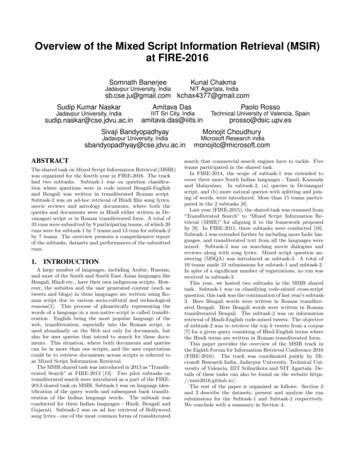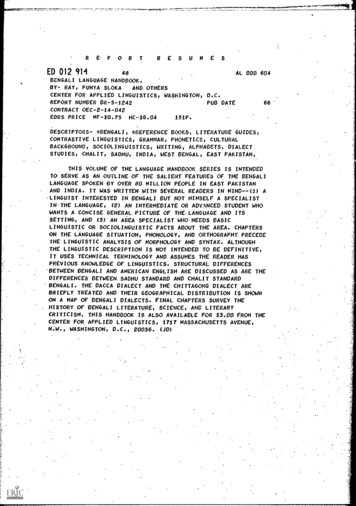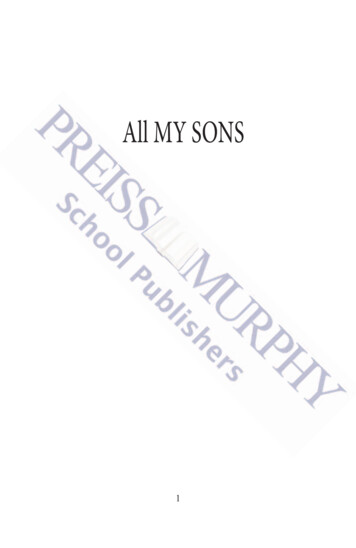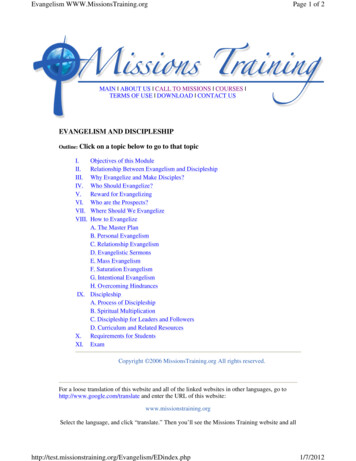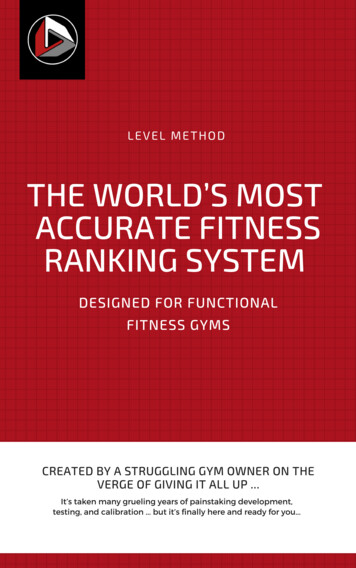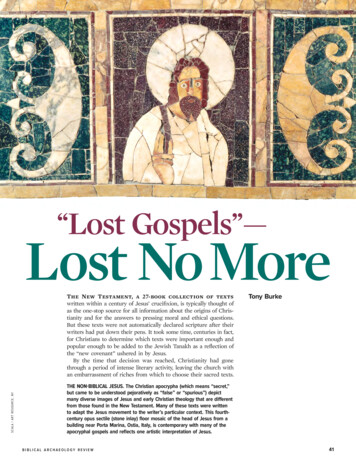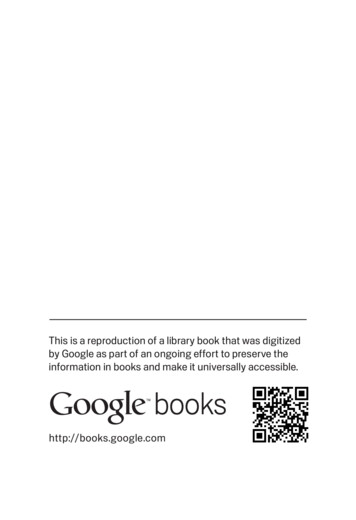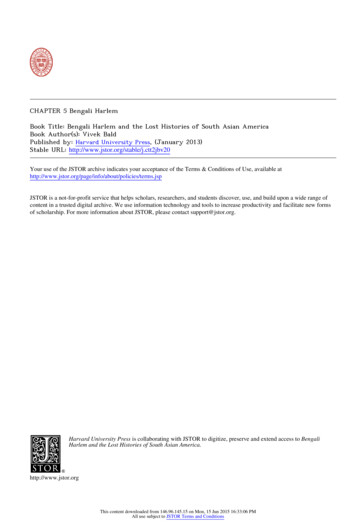
Transcription
CHAPTER 5 Bengali HarlemBook Title: Bengali Harlem and the Lost Histories of South Asian AmericaBook Author(s): Vivek BaldPublished by: Harvard University Press, (January 2013)Stable URL: http://www.jstor.org/stable/j.ctt2jbv20 .Your use of the JSTOR archive indicates your acceptance of the Terms & Conditions of Use, available at ms.jsp.JSTOR is a not-for-profit service that helps scholars, researchers, and students discover, use, and build upon a wide range ofcontent in a trusted digital archive. We use information technology and tools to increase productivity and facilitate new formsof scholarship. For more information about JSTOR, please contact support@jstor.org.Harvard University Press is collaborating with JSTOR to digitize, preserve and extend access to BengaliHarlem and the Lost Histories of South Asian America.http://www.jstor.orgThis content downloaded from 146.96.145.15 on Mon, 15 Jun 2015 16:33:06 PMAll use subject to JSTOR Terms and Conditions
chapter 5Bengali HarlemThere are West Indian, low class Mexican, low class Argentineans, low class Peruvians. They also come from East India. All ofthem, however, when arrested, invariably [say they] are “PortoRican.” In fact the incoming of these people is responsible for anew racket. . . . We have come across groups lately in Harlem whoare selling fake Porto Rican birth certificates for 30 each.—New York City Police Commissioner Mulrooney,the New York Age, March 9, 1932If you had visited New York City in the spring of 1949, taken in aBroadway show—say, Death of a Salesman or South Pacific—and thenhappened to stroll along West Forty-Sixth Street looking to grab a mealat one of the neighborhood’s many and varied restaurants, you may wellhave been tempted up a flight of stairs at number 144 to try the Indianfood at the Bengal Garden. The Bengal Garden was one of a handful ofIndian restaurants that had popped up in the theater district in recentyears. On entering this small, simple, rectangular space, you would havelikely been greeted and seen to your table by a Puerto Rican woman inher midforties. This was Victoria Echevarria Ullah. She ran the front ofthe restaurant and was stationed near the door. At a far corner table nearthe back of the restaurant, you may have noticed a well-dressed anddistinguished-looking South Asian man, seated as if he were in his office,speaking to one or more other men. He might have been speaking in Bengali or Urdu or English, or switching between the languages, dependingon his companions. This was Ibrahim Choudry, one of the owners of the160This content downloaded from 146.96.145.15 on Mon, 15 Jun 2015 16:33:06 PMAll use subject to JSTOR Terms and Conditions
Bengali Harlem 161Bengal Garden, and a founder and officer of multiple community-basedorganizations, some East Pakistani, some Muslim American, and someinterfaith. If you peeked into the back, you would have seen another SouthAsian man—solidly built, serious, and focused—doing everything fromprepping to cooking to plating each dish, moving from one part of thekitchen to the next, sometimes swearing, and making the whole operation work. This was Habib Ullah, the restaurant’s founder and otherco-owner, and Victoria’s husband. At the end of each night, after closing, all three headed uptown to go home. Habib and Victoria lived onthe second floor of a five-story tenement building on a predominantlyPuerto Rican block of East 102nd Street. Ibrahim Choudry had recentlymoved to a place on the other side of town, a ground-floor apartment onWest Ninety-eighth Street, where his neighbors were Puerto Rican andJewish.1All three came to New York City between 1920 and 1935, and theirlives intersected in Harlem. Choudry was likely the first to arrive in thecity. He had been a student leader in East Bengal, had come to the attention of British colonial authorities, and had to flee India. He secured ajob as a serang on an outgoing steamship, worked as a seafarer for a time,and deserted in New York City. Habib Ullah came to the city around thesame time as Choudry. It is unclear how and why he left his village in thedistrict of Noakhali at the age of fourteen, but at that young age he traveled to Calcutta and found a job on an outgoing ship. When his steamerreached the port of Boston, he either jumped ship or fell ill, and his shipcontinued without him. He could not read or write and barely spoke English, but somehow Habib made his way to New York City, where helived with other Bengali ex-seamen on the Lower East Side and foundwork as a dishwasher and line cook. In the 1930s, Habib moved up theLexington Avenue subway line to East Harlem, where more and moreBengalis were settling—and where he met Victoria. Victoria Echevarriahad only recently come to the United States herself, from a neighborhoodon the outskirts of San Juan, Puerto Rico. She was the eldest sister in afamily of seven children, and when she was nineteen, her father died of aheart attack. Unable to find work in San Juan, Victoria set out on herown for New York City. She lived with some aunts and cousins who hadsettled in East Harlem, worked in factories, and started sending moneyThis content downloaded from 146.96.145.15 on Mon, 15 Jun 2015 16:33:06 PMAll use subject to JSTOR Terms and Conditions
162Benga li H a rlemback home.2 The Bengal Garden was the result of these three individuals’ pooling their expertise. Choudry put together the finances to startthe restaurant; Victoria brought skills working with customers and handling the daily accounts; Habib brought his skills as a cook and hisexperience working in commercial kitchens throughout the city.Their meeting and partnership grew out of the dynamic arena of migrations, encounters, and crossings that defined Harlem in the first halfof the twentieth century. Harlem during this period is best known as theepicenter of the African American world. As thousands of AfricanAmericans joined the Great Migration in the opening decades of thetwentieth century, New York City became a destination like no other,and Harlem became the neighborhood of all northern black neighborhoods. “To many oppressed within the limitations set up by the South,”wrote Ray Stannard Baker in 1910, “it is indeed the promised land.”3But Harlem was not just an end-point for southern migration; it was adestination for immigrants from other parts of the black diasporicworld. By the time the first handful of Indian Muslim seamen moveduptown in the mid-1910s, the neighborhood around them was beingtransformed by thousands of immigrants from the English- and Spanishspeaking Caribbean: Jamaica, Barbados, the Bahamas, Puerto Rico,and Cuba. Choudry, Ullah, and other ex-seamen from the subcontinentwere just a drop amid these larger streams of migrants, but they wereone of several such smaller groups quietly settling into the uptownneighborhood, including Argentineans, Colombians, Mexicans, Panamanians, and Chinese.As promising a place as it seemed, most Harlem residents in the 1910s–1930s struggled to get by. Since the turn of the century, more and moreAfrican Americans had moved uptown from other parts of the city inresponse to recurring waves of violence. By the interwar period, NewYork city was starkly divided and unequal; Harlem came to be, in thewords of contemporary observers, a “city within a city,” a “distinct nation,” a “Negro community . . . with as definite lines of demarcation asif cut by a knife.” 4 The neighborhood’s housing and health conditionswere poor, educational opportunities were limited, and the occupationalstructure of New York City was as segregated as its geography. Men ofcolor were relegated to the city’s lowest-paying jobs as unskilled laborersThis content downloaded from 146.96.145.15 on Mon, 15 Jun 2015 16:33:06 PMAll use subject to JSTOR Terms and Conditions
Bengali Harlem 163and ser vice workers—porters, elevator operators, dishwashers. Womenof color arriving from the South or the Caribbean found an even morelimited range of occupations at significantly lower pay; close to threequarters worked in personal and domestic ser vice, while others laboredin garment factories and other light manufacturing or operated boardinghouses. Few of these jobs provided a living wage, so households had topool resources to survive. The economic pressures on Harlem residentsgrew even more intense during the Depression. It was a context thatcould readily foster competition and conflict among the neighborhood’sdifferent groups.5At the same time, as a space of what historian Earl Lewis has termed“overlapping diasporas,” Harlem fostered new forms of identification andnew formations of community. The neighborhood’s varied inhabitantsshared similar pasts and similar circumstances. They came to Harlem inthe wake of antiblack violence in the South and the disruptions of Britishand U.S. rule in the Caribbean. Within one to two generations, most hadmoved from rural to urban settings, and all now faced forms of racialpower in New York that were in some ways as oppressive as those they leftbehind. In Harlem, they maintained connections to previous lifewaysand foodways and formed groups tied to shared origins: the Sons andDaughters of South Carolina, the West Indian Committee of America,the Club Borinquen.6 But the neighborhood also brought people togetheracross differences. It became a center for some of the era’s strongest articulations of pan-African identity and anti-colonial internationalism,while intermarriage between African Americans and Caribbean immigrants brought members of different groups in contact with one anotherat the level of the personal, familial, and everyday.7As they joined the flow into Harlem, South Asian Muslims becamean important, if now forgotten, part of New York City and its uptownneighborhood. Many commuted downtown each day, crowded intosubway trains with their African American, Puerto Rican, and WestIndian neighbors, and worked beside them as doormen, elevator operators, dishwashers, line cooks and factory laborers. Others sold hot dogsfrom pushcarts along Harlem’s main thoroughfares—Lexington Avenue, 110th Street, 116th Street. A handful saved enough money to openIndian restaurants in different parts of the neighborhood, and a selectThis content downloaded from 146.96.145.15 on Mon, 15 Jun 2015 16:33:06 PMAll use subject to JSTOR Terms and Conditions
164Benga li H a rlemfew, like Choudry and Ullah, opened establishments in the heart ofmidtown Manhattan. By the 1940s, members of this population, whowere predominantly from the maritime “sending” regions of East Bengal, established their own association, and spaces of daily gathering.But they too shared much in their pasts and present with the othergroups around them. In Harlem they became part of a heterogeneousMuslim community that included African Americans and immigrantsfrom Africa and the Middle East. And, as had happened in New Orleans,Baltimore, and Detroit, a smaller number of these ex-seamen marriedwomen from their adopted neighborhood, creating, together, a unique ifshort-lived multiracial community.Uptown BastiWhen and how did a community of Bengali Muslim ex-seamen begin tocoalesce in Harlem? Dada Amir Haider Khan has provided a firsthandaccount of the “colony” of Indian “seafaring men” who were living nearManhattan’s west-side waterfront, around 1920. The children of SouthAsian men who jumped ship in New York in subsequent decades provide an equally vivid picture of the Bengali–Puerto Rican–AfricanAmerican community that had formed by the 1940s and 1950s in Harlem and other parts of the city. What happened in the twenty interveningyears, between Khan’s day and midcentury? Archival documents give ussome clues. The federal censuses of 1920 and 1930, draft registration records from the First World War, New York City directories, Manhattanmarriage certificates, and local news stories all bear traces of the workingclass Indian population that was settling into the city during the 1920sand 1930s. Though scattered and disparate, these traces suggest a particular chain of entry into Manhattan: over time, Indian ex-seafarers movedfrom New York’s waterfronts—South Brooklyn, the Syrian district, andHell’s Kitchen—first to the Tenderloin on Manhattan’s West Side, then tothe Lower East Side, and then up the East Side elevated and subway linesinto Central and East Harlem.During and immediately after the First World War, the archives showthat most of the city’s working-class Indian population was living in theTenderloin, a few blocks from the West Side waterfront, in tenementsThis content downloaded from 146.96.145.15 on Mon, 15 Jun 2015 16:33:06 PMAll use subject to JSTOR Terms and Conditions
Bengali Harlem 165spread among the West Thirties and Forties. The characteristics ofthese men bear out Dada Khan’s descriptions and closely mirror thecharacteristics of the Indian maritime and ex-maritime workforce. Theywere young, predominantly Muslim men, mostly nonliterate, workingjobs in restaurants, hotels, and factories and on ships. The largest numberwere from Bengal, and the next largest groups appear to have been fromPunjab and the Northwest Frontier, with a smaller number from Goa andCeylon. Even as they were concentrated on the West Side, men from thisdemographic began to turn up in both the Lower East Side and Harlemduring the war years. In 1918, for example, draft registrars recorded atwenty-five-year-old Indian Muslim man, Shooleiman Collu, living onForsyth Street in the middle of the Lower East Side, working as an itinerant peddler.8 Two years later, a federal census taker found Fayaz Zaman residing a few blocks away in a building of Jewish immigrants fromRussia and Poland, working as a nickel plater in a local foundry. TheIndian presence in Harlem at this time was larger, but less clearly tiedto the maritime trade. There were several Caribbean migrants of Indian descent living in Central Harlem among other recent arrivals fromBritish Guiana, Trinidad, and St. Vincent—Hugh and Rose Persaud,Lennox Maharage, Duncan Bourne, Byesing Roy—as well as men whohad Anglicized their names—Edward Stevenson, Jack Amere, JosephHarris. There was one Indian woman, Jane Williams, who was working as a maid for a Jewish family on West 120th Street, and there wasRanji Smile, a curry cook who had taken New York’s high society bystorm at the turn of the century and was now living in the West 130s.Yet, here again, scattered throughout the neighborhood, were men whofit the profi le of escaped Indian seafarers: Nazir Ahmed, who was working as an elevator operator; Aladin Khan, a porter for a downtowncandy company; Samuel Ali, a worker in a button factory; MohammedKarim, a hotel cook.9By the early 1930s, city and federal officials were recording a significantly larger population of working-class Indian men than previously,and their presence on the Lower East Side and in Harlem was becoming more concentrated and more distinct. About two dozen IndianMuslim men were living in the crowded tenements of the Lower EastSide in a series of shared apartments on Clinton, Rivington, Norfolk,This content downloaded from 146.96.145.15 on Mon, 15 Jun 2015 16:33:06 PMAll use subject to JSTOR Terms and Conditions
166Benga li H a rlemSuffolk, Eldridge, and Orchard Streets. They were between nineteen andthirty-five years old and mostly worked in restaurants and hotels as doormen, porters, elevator operators, line cooks, busboys, dishwashers,countermen, and waiters. There were likely more of these men than whatthe documents show, as many would have thought it best to avoid censustakers and other officials. It is possible, in fact, that Indian men weredrawn to the Lower East Side not just because of its low-rent tenements, but also because they could disappear into its dense populationof immigrants from Eastern and Southern Europe. It is possible, in addition, that they were drawn to the neighborhood because of its kosherbutchers, who, in the absence of a local Muslim community, providedthe closest available approximation of halal meat. Uptown, however,the Indian population was even larger than it was on the Lower EastSide. When federal census takers canvassed Harlem in April 1930, theyrecorded more than sixty-five Indian men residing at roughly forty-fivedifferent addresses throughout the neighborhood. Most of these menwere clustered in two areas: East Harlem (in the eighteen city blocksbetween East Ninety-Eighth and 103rd Streets and Lexington and FirstAvenues), where their neighbors were primarily immigrants from PuertoRico, Cuba, and the Dominican Republic, and lower Central Harlem(in the six city blocks bounded by West 112th and 118th Streets andLenox and Fifth Avenues), where their neighbors were Puerto Rican,Cuban, African American and West Indian (Map 2).10 It was here, NewYork’s police commissioner claimed in 1932, that men from the subcontinent, barred from officially becoming part of the U.S. nation, soughtto disappear into the communities around them, to pass, or even to gainnew legal identities as Puerto Rican.11By now, an increasing number of Indian Muslim ex-seamen were marrying within local communities of color. While roughly half the Indianpopulation uptown in the 1930s were single men living as boarders or insmall group households, one-third had married and were living withtheir Puerto Rican, African American, or West Indian spouses. The records of these unions are scattered among the thousands of New York Citymarriage certificates issued from the early 1920s through the late 1930s(Table 4). The majority of men listed in these records were in theirtwenties when they got married. They were either working in restaurantsor doing other kinds of manual or semiskilled labor—ranging from silkThis content downloaded from 146.96.145.15 on Mon, 15 Jun 2015 16:33:06 PMAll use subject to JSTOR Terms and Conditions
Map 2. Residences of Indians in Harlem, 1917–1937. Sources: USSS/DRCWWI Registration Cards (various, 1917–1918); USDC/BC, Population Schedulesfor New York, NY (various, 1920, 1930); CNY, Certificates and Records ofMarriage (various, 1920–1937); New York Amsterdam News, Marriage Notices andCrime Reports (various, 1926–1937).This content downloaded from 146.96.145.15 on Mon, 15 Jun 2015 16:33:06 PMAll use subject to JSTOR Terms and Conditions
This content downloaded from 146.96.145.15 on Mon, 15 Jun 2015 16:33:06 PMAll use subject to JSTOR Terms and ConditionsJohn KhanCarmen GuzmanMohammed AbdulSadie SimmondsMuslim MiaGrace M. DunbarRustum AlliBeatrice OwensAbdul HassanEthel LeVineSolomon KhanAgnes WeeksNawab AliFrances SantosMokhd AliMable Leola GibsonSeconder AliMaria SedenoFebruary 7, 1923April 1, 1929June 2, 1927July 10, 1926February 10, 1926September 2, 1925September 1, 1925January 3, 1925August 16, e1803 3rd Ave.1985 2nd Ave.1803 3rd Ave.314 W. 133rd St.3411 2 W. 4th St.191 W. 134th St.202 Broome St.202 Broome St.70 Broome St.70 Broome St.1808 3rd Ave.9 E. 130th St.222 E. 100th St.317 E. 100th St.2971 W. 36th St.36 W. 128th St.69 W. 115th St.54 E. 116th St.AddressTable 4. Indian Mixed Marriages, Harlem and Lower East Side, eWhiteWhiteColorLaundry n—Salesman—Laundry Man—Chauffer—Laborer—OccupationIndiaPorto RicoIndiaBrooklyn, NYIndiaElmira, NYEast IndiaJacksonville, FloridaIndiaNew York, NYCalcutta, IndiaBarbados, BWICalcutta, Br. East IndiesPorto RicoBangol, IndiaBaltimore, MDBombay, IndiaSan Juan, Puerto RicoBirthplace
This content downloaded from 146.96.145.15 on Mon, 15 Jun 2015 16:33:06 PMAll use subject to JSTOR Terms and ConditionsWohad AliMaria Louisa RiveraCaramath AliCarolina GreenNawab AliBernardina ColonKassim UllahFrances EnglishHabib AliDolores VeleraNabob AliMaria Cleophe JusinoKurban AliEsther MoulierEleman MiahEmma L. DouglassKala MiahProvidencia Matas231926272916272223222822251727223026307 E. 100th St.102 E. 103rd St.1978 2nd Ave.230 E. 99th St.222 E. 98th St.222 E. 98th St.329 Grand St.217 Grand St.90 Orchard St.42 Rivington St.57 E. 110th St.57 E. 110th St.84 W. 115th St.79 E. 109th St.39 W. 112th St.183 W. 115th St.1769 3rd Ave.46 E. 112th St.Proper names and place names are spelled as they appear on the original marriage documents.Source: City of New York, Certificates and Record of Marriage, 1899–1937.August 23, 1937June 26, 1937April 24, 1937December 14, 1934January 18, 1933October 3, 1930August 2, 1930August 2, 1930January 7, redColoredWhiteWhiteWhiteWhiteWhiteEast IndianColoredColoredColoredLaundry Work—Bell Boy—Laundry Work—Painter—Waiter—Cook—Silk Dyeing—Cook’s Helper—Laborer—IndiaVega Baja, Puerto RicoEast IndiaDominican RepublicCalcutta, IndiaJuana Diaz, Puerto RicoEast IndiaCarlisle, South CarolinaCalcutta, IndiaPuerto RicoCalcutta, IndiaSabana Grande, P.R.IndiaSanturce, Puerto RicoCalcutta, IndiaIndianapolis, INIndiaSan Juan, Puerto Rico
170Benga li H a rlemdyeing to automobile repair. Many listed “Calcutta” or “Bengal”—ratherthan simply “East India”—as their place of birth. The women they married were primarily in their late teens and early twenties and were eitherAfrican American women from various parts of the United States—NewYork; Baltimore; Jacksonville, Florida; Carlisle, South Carolina—or womenfrom Puerto Rico—San Juan, Vega Baja, Santurce—and in one case, theDominican Republic. While the African American women in these recordswere consistently listed as “Colored” or “Negro” and the Puerto Ricanwomen were in most instances classified as “White,” the Indian groomsseemed to confound the city marriage clerks’ understandings of race. Whenit came to “color,” these men were classified in every possible way: white,colored, Negro, Indian, and East Indian.12The mixed marriages did not go unnoticed in Harlem’s local press. Inthe late 1920s, unions between Indian men and African American andPuerto Rican women began to appear in the pages of the neighborhood’smost prominent black periodical, the New York Amsterdam News. Initially, these were simply entries among the newspaper’s lists of the neighborhood’s marriage certificate “issues”; in June 1927, for example, theissue of licenses to “Ali, Mokhd, 2971 West 36th street [and] Miss MabelLeola Gibson, 36 West 128th Street” as well as to “Kriam, Abdul, 322West 141st street and Miss Mildred Hayes, 242 West 146th street,” wereamong a list of fifty-five “recent issues.”13 In 1932, a similar certificate issue warranted its own short paragraph. Under the headline “To WedEast Indian,” the Amsterdam News wrote, “Nosir Meah, 27, who said thathe was born in Bombay, India, has obtained a license to wed Miss LillianPonds, a domestic, 1926 Second avenue. Meah lives at 301 West 102dstreet.”14 By 1935, the News reported at greater length not merely on theissue of a marriage license, but also on the private reception following anIndian–African American wedding. Both the content and the tone of thearticle—familiar and matter-of-fact—suggest that such occurrences weregradually becoming a normal part of the social life of Harlem:The many friends of Mr. and Mrs. Syedali Miah, newlyweds, attended a wedding reception in their honor at their home, 260 West125th Street, last Friday evening. The Miahs were married at theThis content downloaded from 146.96.145.15 on Mon, 15 Jun 2015 16:33:06 PMAll use subject to JSTOR Terms and Conditions
Bengali Harlem 171Eighteenth Street Methodist Church . . . on April 5. The Rev.Charles F. Divine officiated. Mrs. Miah, formerly Miss MargueriteRichardson, is the daughter of Harper Richardson, 401 West 149thstreet. Her uncle, Charlie Anderson, with whom she made herhome, is a well-known dancing teacher with studios at 2323 SeventhAvenue. Mr. Miah is a native of Bengal, India.15The Amsterdam News did not merely report on the joyous moments ofsuch marriages, however. Its pages suggest that these unions were complicated and that lives on both “sides” of each marriage could be precarious. On March 1, 1933, for example, the paper reported on the sentencingof “Kotio Miah . . . formerly of 267 West 137th street” to “two-and-a-halfto five years” on charges of bigamy. “Miah’s first wife, Belicia Jimenez,”the News wrote, “a South American whom he married in 1927, claimedthat he left her in 1932 to marry Carmen Jimenez, a Porto Rican, withoutobtaining a divorce. Miah’s trial was unique in the annals of GeneralSessions in that the defendant was convicted, his attorney was fined 25for contempt of court, and his six witnesses, all hailing from India, werearrested by immigration officials for unlawful entry into the country asfast as they left the witness stand.”16The appearance of Indian men in the Amsterdam News’ crime reportsprovides another view of their entry into the everyday life of Harlem during the late 1920s and early 1930s. As in Kotio Miah’s bigamy case, theIndians appeared in these reports both as accused perpetrators and asvictims:March 10, 1926: Hubidad Ullah . . . said that he came uptown tohave a good time with two other friends. . . . [T]hey were standingon the corner of 134th street and Lenox avenue when he saw [Fannie]Dials . . . whom he had known for about one week. . . . Hubidadsaid that she insisted upon them going to her apartment. . . . [He]said that he was invited into a separate room by the woman, whohugged and kissed him repeatedly. Having a slight craving formore whiskey, Hubidad . . . went into his pocket to get more moneyand . . . [discovered] his wallet [was missing].This content downloaded from 146.96.145.15 on Mon, 15 Jun 2015 16:33:06 PMAll use subject to JSTOR Terms and Conditions
172Benga li H a rlemApril 9, 1930: Wyatt Griffin, 24, 103 West 121st street, was held without bail when charged by Abdul Mohammed, 2051 Seventh avenue,with luring him into [a] hallway . . . where he is alleged to have attempted to rob [Mohammed] after threatening him with a blackjack.April 23, 1930: Abdul Hack, 35, 225 East Ninety-ninth street, washeld without bail for a further hearing on a charge of illegally possessing drugs.November 19, 1930: Abdul Kader, an East Indian, 124 West 127thstreet, was taken to Bellevue Hospital for observation Thursdayevening by police after he had terrified tenants of the apartment inwhich he lived. Kader brandished a revolver and shot at residentsuntil he was subdued by two policemen.17While they present only glimpses of lives in moments of crisis, whenentanglements with sexual desire, petty crime, mental anguish, and violence erupted into public view, these early fragments of evidence suggestan Indian population that was already part of the fabric of intimate relationships and daily struggles of Depression-era Harlem.Hot Dogs and CurryBy the 1930s, Indian men were working in a wide variety of jobs acrossthe city; the ex-maritime population was integrating into the larger fabric of working-class life both in Harlem and in New York City as a whole.The 1930 census shows that their occupations ran the gamut of service industry and semiskilled work: “counterman . . . chauffer . . . fireman . . .porter . . . elevator operator . . . laundry worker . . . meat worker . . .dress factory helper . . . mechanic . . . painter . . . packer . . . subway laborer.”18 For a smaller number of men, Harlem appears to have provideda field in which to pursue different kinds of possibilities, beyond therealm of ser vice work and manual labor. S. Abedin, who listed his occupation as “shellac importer,” shared an apartment on 119th Street inCentral Harlem with a mechanic, M. Yusef, and a restaurant laborer,Ghulam Husein. Four self-employed “artists,” Harry, Raymond, Abra-This content downloaded from 146.96.145.15 on Mon, 15 Jun 2015 16:33:06 PMAll use subject to JSTOR Terms and Conditions
Bengali Harlem 173ham, and Emanuel Rahman, lived on 111th Street and Lenox Avenue,and one “artist’s model,” Mougal Khan, lived on 129th Street betweenFifth and Lenox Avenues.19 For those who sought a way out of restaurant, hotel, and factory jobs, however, there appear to have been twomuch more common paths: either they found semi-independent work asfood vendors on the streets or they opened restaurants and other smallbusinesses of their own.Helen Ullah, a Puerto Rican resident of East Harlem who married aBengali ex-seaman—Saad “Victor” Ullah—in the mid-1940s, describesa string of Indian Muslim hot-dog vendors who were operating in EastHarlem at that time, selling from pushcarts up and down Madison, Lexington, and Third Avenues. Much more than those who worked in factories all day or in the kitchens and basements of midtown restaurants andhotels, these men became a part of the everyday social landscape of Harlem, serving and interacting with the whole range of people who lived andworked in the neighborhood. They were also key to maintaining a fabricof community among the different Indian men and their families in thearea; Indians would visit their friends’ pushcarts on their way through theneighborhood each day, says Ullah, both to catch up on news and gossip—“to stop and say ‘Hello, how are you?’ and ‘How are the kids?’ and soforth”—and to eat the hot dogs themselves: “If it was pork, they wouldn’ttouch it, but they always knew it was safe to eat from other Indians’ wagons.” For Helen’s youngest sister, Felita, the hot-dog vendors were a guarantee of safe passage through the neighborhood; as a child, she remembersnavigating from one pushcart to the next, knowing that her brother-in-lawSaad’s friends would keep a watchful eye on her.20 Those men who couldsave or raise enough capital, and who could navigate the legal terrain, wenta step further to start up businesses and restaurants. The businesses wereusually modest ventures. “They would set
Book Title: Bengali Harlem and the Lost Histories of South Asian America Book Author(s): Vivek Bald . She was the eldest sister in a family of seven children, and when she was nineteen, her father died of a heart attack. Unable to fi nd work in San Juan, Victoria set out on her own for New

